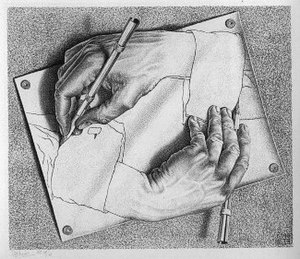
Drawing Hands, 1948
Image via Wikipedia
Saturday Larisa, Dima, Tim & I were very excited to visit this special exhibition at the New Britain Museum of American Art. There were 130 works of the Dutch graphic artist M. C. Escher on display, most, if not all of them, from the collection owned by the Herakleidon Museum in Athens, Greece. There is a photo gallery at the bottom of this web page that shows many of the works we got to examine yesterday.
The Herakleidon Museum’s collection consists of more than of 250 of Escher’s “most important and rare works as well as woodcuts, mezzotints, lithographs, photographs of the artist, sculptures and many of his personal items.” At the New Britain Museum of American Art we got to see “the extremely rare lithograph stone for the making of Flat Worms.”
According to the museum’s website: “Maurits Cornelis Escher (1898-1972) has earned worldwide acclaim as a master printmaker, draftsman, book illustrator, and muralist. Though never having studied extensively in mathematics, the mind-bending techniques and impossible realities depicted in M. C. Escher’s works prove him a brilliant mathematician. Much of Escher’s work is intuitive; without focusing on labels, Escher created what came to him instinctively.“

I picked up this book in the gift shop which includes Escher’s comments on some of his works. Wish I could include some illustrations in this post, but every picture of his work is copyrighted! But here is a link to the Oldest Escher Collection on the Web.
My two favorites were “Hand with reflecting globe” and “G.A. Escher,” a drawing of his father at age 92, reading a paper with a magnifying glass. We also learned that Escher had a half-brother, Berend George Escher, a Dutch geologist, who influenced M. C.’s work with his knowledge of crystals. Tim had four favorites: “Metamorphose,” “Mosaic I,” “Moebius band II,” and, shown at the beginning of this post, “Drawing hands.”
The exhibit will be in New Britain, Connecticut, until November 14, and then will be traveling to the Akron Art Museum in Akron, Ohio. Not sure if that’s it, but it is definitely worth making an effort to see. I loved one of Escher’s quotes they had on display:
He who wonders discovers that this is in itself a wonder.
~ M. C. Escher
I wish I were still in New England so I could check this out! I love your blog, and appreciate your comment on mine – not sure how you found me, but I’m glad you did 🙂
Thank you, Dianna! I’m not sure how I found your wonderful blog, either. Sometimes I start clicking on one blogroll after another and wind up visiting all sorts of blogs! Probably the title “Sea Salt” attracted me… 🙂
The ‘hand with reflecting globe’ one has always been my favourite. I was crazy about Escher’s art when I was a teen and always wanted to draw like him, it’s possibly why I was always doing surreal b&w stuff that changed depending how one looked at it! I never managed those types of trick of the eye perceptions though.
I still enjoy his work. Thanks for the ‘revisit’!
🙂
That’s awesome that we like the same Escher drawing! It seems like he was in a class by himself, though I have seen a few drawings by artists who were inspired by his works that weren’t bad. My head was kind of spinning after an hour and a half of those tricks on my poor eyes… Took a Zomig and fell asleep in the car on the way home, but it was worth it!! I admire artists, including you!
Thank you Barbara.
🙂
Thank-you very much for the link to the wonderful Escher works. I wish I could go to it. Also thanks for the link to the New Britain Museum of American Art. The children’s guide to art there looks much more useful than many I have seen – I might be able to use it at school.
You’re welcome, Sonya! I checked out the children’s guide since you mentioned it and found it easy to use and understand. I think it would be very useful for adults, too. Are you a teacher? Thanks for stopping by my blog!
I have always enjoyed Escher’s work. I like art that attempts to describe what seems to be impossible. This is a lovely blog, Barbara.
Thank you, Kathy! I’m with you, anything that challenges our notions of reality, perception and possibility. I wonder what it was like having his mind and his way of interpreting the world around him.